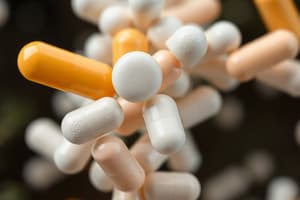Podcast
Questions and Answers
Which beta-lactam antibiotic is known for having broad-spectrum coverage, including against Gram-negative bacteria?
Which beta-lactam antibiotic is known for having broad-spectrum coverage, including against Gram-negative bacteria?
- Methicillin
- Penicillin G
- Cephalexin
- Carbapenems (correct)
What is the primary mechanism of action of aminoglycosides?
What is the primary mechanism of action of aminoglycosides?
- Inhibit DNA gyrase
- Inhibit cell wall synthesis
- Inhibit folic acid synthesis
- Bind to 30S ribosomal subunit (correct)
Which antibiotic is specifically indicated for treating MRSA infections?
Which antibiotic is specifically indicated for treating MRSA infections?
- Ceftaroline (correct)
- Cefepime
- Penicillin V
- Vancomycin
What is the consequence of using chloramphenicol in infants?
What is the consequence of using chloramphenicol in infants?
Which of the following antibiotics is an effective treatment for UTI while targeting multiple cellular processes?
Which of the following antibiotics is an effective treatment for UTI while targeting multiple cellular processes?
What is the main side effect associated with tetracyclines?
What is the main side effect associated with tetracyclines?
Which of the following agents does NOT have an effect on DNA synthesis?
Which of the following agents does NOT have an effect on DNA synthesis?
Which antimicrobial resistance testing method is used for vancomycin-resistant strains?
Which antimicrobial resistance testing method is used for vancomycin-resistant strains?
What commonly used medication inhibits the synthesis of mycolic acid, making it effective against Mycobacterium?
What commonly used medication inhibits the synthesis of mycolic acid, making it effective against Mycobacterium?
Which antifungal agent is primarily used for severe systemic fungal infections but has a risk of nephrotoxicity?
Which antifungal agent is primarily used for severe systemic fungal infections but has a risk of nephrotoxicity?
Match the following beta-lactam antibiotics with their characteristics:
Match the following beta-lactam antibiotics with their characteristics:
Match the following protein synthesis inhibitors with their unique features:
Match the following protein synthesis inhibitors with their unique features:
Match the following antifungal agents with their specific uses:
Match the following antifungal agents with their specific uses:
Match the following medications with their corresponding actions:
Match the following medications with their corresponding actions:
Match the following antimycobacterial agents with their side effects:
Match the following antimycobacterial agents with their side effects:
Match the following cell membrane disruptors with their targets:
Match the following cell membrane disruptors with their targets:
Match the following antiviral agents with their specific targets:
Match the following antiviral agents with their specific targets:
Match the following antimicrobial resistance testing methods with their targets:
Match the following antimicrobial resistance testing methods with their targets:
Match the following agents with their mechanisms of action:
Match the following agents with their mechanisms of action:
Match the following generations of cephalosporins with their properties:
Match the following generations of cephalosporins with their properties:
Flashcards
Beta-Lactam Antibiotics
Beta-Lactam Antibiotics
A class of antibiotics that inhibit cell wall synthesis by interfering with peptidoglycan formation.
Penicillin G/V
Penicillin G/V
Beta-lactam antibiotics effective against Gram-positive bacteria like Streptococcus.
Methicillin/Oxacillin
Methicillin/Oxacillin
Beta-lactam antibiotics resistant to bacterial enzymes that break them down (beta-lactamases).
Ampicillin/Carbenicillin
Ampicillin/Carbenicillin
Signup and view all the flashcards
Carbapenems
Carbapenems
Signup and view all the flashcards
Vancomycin
Vancomycin
Signup and view all the flashcards
1st Generation Cephalosporins
1st Generation Cephalosporins
Signup and view all the flashcards
2nd Generation Cephalosporins
2nd Generation Cephalosporins
Signup and view all the flashcards
3rd Generation Cephalosporins
3rd Generation Cephalosporins
Signup and view all the flashcards
4th Generation Cephalosporins
4th Generation Cephalosporins
Signup and view all the flashcards
5th Generation Cephalosporins
5th Generation Cephalosporins
Signup and view all the flashcards
Cell Membrane Disruptors
Cell Membrane Disruptors
Signup and view all the flashcards
Bacitracin
Bacitracin
Signup and view all the flashcards
Polymyxins
Polymyxins
Signup and view all the flashcards
Aminoglycosides
Aminoglycosides
Signup and view all the flashcards
Aminoglycoside Examples (e.g., Tobramycin/Gentamicin)
Aminoglycoside Examples (e.g., Tobramycin/Gentamicin)
Signup and view all the flashcards
Tetracyclines
Tetracyclines
Signup and view all the flashcards
Macrolides
Macrolides
Signup and view all the flashcards
Erythromycin
Erythromycin
Signup and view all the flashcards
Chloramphenicol
Chloramphenicol
Signup and view all the flashcards
Folic Acid Inhibitors
Folic Acid Inhibitors
Signup and view all the flashcards
Trimethoprim/Sulfamethoxazole
Trimethoprim/Sulfamethoxazole
Signup and view all the flashcards
DNA Synthesis Inhibitors
DNA Synthesis Inhibitors
Signup and view all the flashcards
Nalidixic Acid
Nalidixic Acid
Signup and view all the flashcards
Fluoroquinolones
Fluoroquinolones
Signup and view all the flashcards
Nitrofurantoin
Nitrofurantoin
Signup and view all the flashcards
Rifampin
Rifampin
Signup and view all the flashcards
Metronidazole
Metronidazole
Signup and view all the flashcards
Antimycobacterial Agents
Antimycobacterial Agents
Signup and view all the flashcards
Isoniazid
Isoniazid
Signup and view all the flashcards
Ethambutol
Ethambutol
Signup and view all the flashcards
Pyrazinamide
Pyrazinamide
Signup and view all the flashcards
Antifungal Agents
Antifungal Agents
Signup and view all the flashcards
Amphotericin B
Amphotericin B
Signup and view all the flashcards
Azoles
Azoles
Signup and view all the flashcards
5-Fluorocytosine
5-Fluorocytosine
Signup and view all the flashcards
Caspofungin
Caspofungin
Signup and view all the flashcards
Antiviral Agents
Antiviral Agents
Signup and view all the flashcards
Acyclovir
Acyclovir
Signup and view all the flashcards
Ribavirin
Ribavirin
Signup and view all the flashcards
Neuraminidase Inhibitors
Neuraminidase Inhibitors
Signup and view all the flashcards
Antimicrobial Resistance Testing
Antimicrobial Resistance Testing
Signup and view all the flashcards
MRSA
MRSA
Signup and view all the flashcards
VRSA
VRSA
Signup and view all the flashcards
Beta-Lactam Antibiotics
Beta-Lactam Antibiotics
Signup and view all the flashcards
Penicillin G/V
Penicillin G/V
Signup and view all the flashcards
Methicillin/Oxacillin
Methicillin/Oxacillin
Signup and view all the flashcards
Ampicillin/Carbenicillin
Ampicillin/Carbenicillin
Signup and view all the flashcards
Carbapenems
Carbapenems
Signup and view all the flashcards
Vancomycin
Vancomycin
Signup and view all the flashcards
1st Gen Cephalosporins
1st Gen Cephalosporins
Signup and view all the flashcards
2nd Gen Cephalosporins
2nd Gen Cephalosporins
Signup and view all the flashcards
3rd Gen Cephalosporins
3rd Gen Cephalosporins
Signup and view all the flashcards
4th Gen Cephalosporins
4th Gen Cephalosporins
Signup and view all the flashcards
5th Gen Cephalosporins
5th Gen Cephalosporins
Signup and view all the flashcards
Cell Membrane Disruptors
Cell Membrane Disruptors
Signup and view all the flashcards
Bacitracin
Bacitracin
Signup and view all the flashcards
Polymyxins
Polymyxins
Signup and view all the flashcards
Aminoglycosides
Aminoglycosides
Signup and view all the flashcards
Aminoglycosides (e.g., Tobramycin/Gentamicin)
Aminoglycosides (e.g., Tobramycin/Gentamicin)
Signup and view all the flashcards
Tetracyclines
Tetracyclines
Signup and view all the flashcards
Macrolides
Macrolides
Signup and view all the flashcards
Erythromycin
Erythromycin
Signup and view all the flashcards
Chloramphenicol
Chloramphenicol
Signup and view all the flashcards
Folic Acid Inhibitors
Folic Acid Inhibitors
Signup and view all the flashcards
Trimethoprim/Sulfamethoxazole
Trimethoprim/Sulfamethoxazole
Signup and view all the flashcards
Study Notes
Beta-Lactam Antibiotics
- Inhibit cell wall synthesis by targeting peptidoglycan
- Penicillin G and V: Active against gram-positive bacteria, used to treat streptococcal infections.
- Methicillin/Oxacillin: Active against gram-positive bacteria, resistant to beta-lactamases.
- Ampicillin/Carbenicillin: Broad-spectrum, effective against a wider range of bacteria.
- Carbapenems: Broadest spectrum, used for severe infections.
- Vancomycin: Glycopeptide, interferes with cross-linking, has a narrow therapeutic index (requires careful monitoring).
Cephalosporins
- First Generation (Cephalexin/Cephalothin): Active against gram-positive bacteria.
- Second Generation (Cefuroxime): Extended spectrum, effective against gram-negative bacteria.
- Third Generation (Ceftriaxone/Cefotaxime): Used for central nervous system infections.
- Fourth Generation (Cefepime): Effective against some third-generation resistant bacteria.
- Fifth Generation (Ceftaroline): Effective against methicillin-resistant Staphylococcus aureus (MRSA).
Cell Membrane Disruptors
- Bacitracin: Active against gram-positive bacteria, inhibits peptidoglycan addition.
- Polymyxins: Active against gram-negative bacteria, disrupt the outer membrane.
Protein Synthesis Inhibitors
- Aminoglycosides: Broad-spectrum, bind to 30S ribosomes; have a narrow therapeutic index (require careful monitoring).
- Tobramycin/Gentamicin: Example aminoglycosides needing close monitoring for toxicity.
- Tetracyclines: Broad-spectrum, bind to 30S ribosomes; can deposit in teeth.
- Macrolides: Bind to 50S ribosomes, used for patients allergic to penicillins.
- Erythromycin: Example macrolide used to treat streptococcal infections.
- Chloramphenicol: Binds to 50S ribosomes, reserved for serious infections; associated with "grey baby syndrome".
Folic Acid Inhibitors
- Trimethoprim/Sulfamethoxazole: Treats chronic urinary tract infections (UTIs), inhibit folic acid synthesis.
DNA Synthesis Inhibitors
- Nalidixic Acid: Treats UTIs, inhibits DNA synthesis.
- Fluoroquinolones: Inhibit DNA gyrase, stopping DNA replication.
- Nitrofurantoin: UTI treatment, targets multiple cellular processes.
- Rifampin: Inhibits DNA polymerase; effective against Mycobacterium species.
- Metronidazole: Causes DNA breaks under anaerobic conditions; produces a metallic taste as a side effect.
Antimycobacterial Agents
- Isoniazid: Inhibits mycolic acid synthesis; can cause hepatitis.
- Ethambutol: Inhibits cell wall formation; can cause optic neuritis.
- Pyrazinamide: Lowers pH; can cause gastrointestinal upset.
Antifungal Agents
- Amphotericin B: Drug of choice for severe fungal infections; has nephrotoxicity (kidney damage) risk.
- Azoles: Inhibit sterol synthesis.
- 5-Fluorocytosine: Effective against Cryptococcus species; can depress bone marrow.
- Caspofungin: Effective against Candida and Aspergillus; not effective against Cryptococcus.
Antiviral Agents
- Acyclovir: Effective against herpes viruses.
- Ribavirin: Effective against respiratory syncytial viruses.
- M2 Inhibitor: Inhibits influenza A virus.
- Neuraminidase Inhibitors: Inhibit influenza A and B viruses.
Antimicrobial Resistance Testing
- MRSA: mecA gene produces an altered penicillin-binding protein (PBP2a).
- VRSA: Tested using an Etest.
- ESBL: Tested using a method involving clavulanic acid.
- Clindamycin Resistance (Erm gene): Tested for the presence of the Erm gene.
- Carbapenemase: Modified Hodge Test.
- Glycopeptides (Vancomycin resistance): van A PCR.
- Oxacillin Resistance: Cefoxitin Disk test.
- Penicillin Resistance (Beta-lactamase): Tested for the presence of beta-lactamase.
Studying That Suits You
Use AI to generate personalized quizzes and flashcards to suit your learning preferences.
Description
This quiz focuses on the mechanisms and classifications of beta-lactam antibiotics and cephalosporins. You'll learn about their action against different types of bacteria and the specific antibiotics used for various infections. Test your knowledge on these crucial medications and their clinical applications.




